There are many ways to create an NGO website that helps you get your message across and start building your partnership network. One of the easiest and most efficient ways is to use a DIY website builder. This helps you save on costs for custom web design, and launch your website quickly and easily while retaining control of all aspects of it.
There are many platforms out there you could use, but the best nonprofit website builder for you would be the one that enables you to create a professionally-looking website at a small cost or for free — and also that is easy to use.
In this guide, we’ll discuss all these elements and give you 10 tips for how to build a website that will help your nonprofit get the support it needs to grow.
» Want to save money for your business? Check out our top 10 money-saving tips for small businesses.
What Should a Nonprofit Website Include?
There are a number of elements that you must include in your website, such as:
Your mission statement
Your past, current, and future projects
A blog page to talk about your achievements
A clear call to action
A simple donations form
Social media links
Building a Nonprofit Website
1. Use a Website Builder
The first thing you need to know about building a website for your nonprofit is that it doesn’t have to be incredibly expensive or time-consuming. Do-it-yourself website builders like Wix, Squarespace, and others make it easy to build a website without professional design experience and or coding knowledge. Some of them have free versions, enabling NGOs to get online even on a very tight budget. Free websites for nonprofits are definitely a growing niche.
Here’s how to create a nonprofit website for free:
Find a website builder that has a free plan, such as Wix, SITE123, or Jimdo
When you sign up, make sure you select the free plan and not the free trial
Build your website
Launch it once you’re happy with the result
Keep in mind that if you’re using a free version, your site will likely contain ads and won’t be on a custom domain.
Using a nonprofit website builder comes with hand-crafted templates to get your site started and inspire your design. Wix has 16 different templates designed specifically for nonprofits, and it’s easy to customize any of the platform’s more than 800 other templates to suit your organization. Drag-and-drop page editors let you add your own text, images, videos, and more, so you can spend as much or as little time as you want creating your nonprofit’s website.

»Not sure which website builder is right for you? Check out these Webflow Alternatives and get started today
2. Be Clear About Your Mission
One of the most important things that a nonprofit website needs to communicate to visitors is your organization’s mission. You need to succinctly explain what your nonprofit does and why it’s important.
It’s a good idea to share your mission with visitors as soon as they land on your website. In other words, put it in a prominent spot on your homepage. You don’t need to go into a huge amount of detail here—just enough to make it clear what your nonprofit is for and encourage visitors to learn more.

You can also include a page on your website dedicated to describing your organization’s mission in more detail. This is a great place to dive into a brief background on the problem your nonprofit is addressing as well as explain how the approach you are taking is new and unique. Adding multimedia here—like a short video, a timeline, or conceptual graphics—can go a long way towards effectively communicating your mission to viewers.
» New to website building? Avoid these common website building mistakes.
3. Include a Projects Page
Once visitors have understood your mission they’ll want to know what you’ve accomplished so far. That’s why your nonprofit website must have a projects page. You can provide an overview of the different efforts that your organization has underway as well as projects you’re hoping to take on in the future. To make things simple for viewers, consider offering a brief summary of each project that includes its aims, timeline, and major successes.
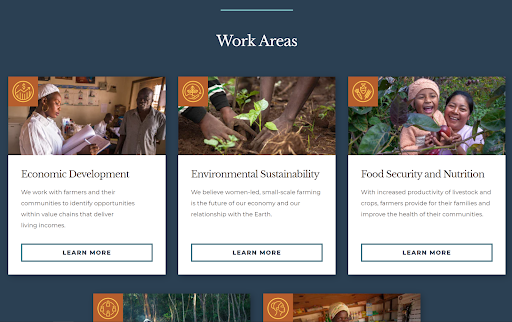
Importantly, the projects page can serve as a central hub within your website. Instead of including links to each project or focus area in your main navigation menu, you can send visitors to the projects page and then link to additional pages from there.
4. Add a Blog to Show Off Your Work
Adding a blog to your nonprofit’s website has a ton of benefits. First, it’s a great way to offer more detail on what your organization is up to and to introduce the people that make your work possible. For example, you can create a series of posts that highlight your staff members and why they love working with your nonprofit. You can also recap volunteer events or fundraising drives, which encourage people to help out or donate the next time your organization puts out a call.
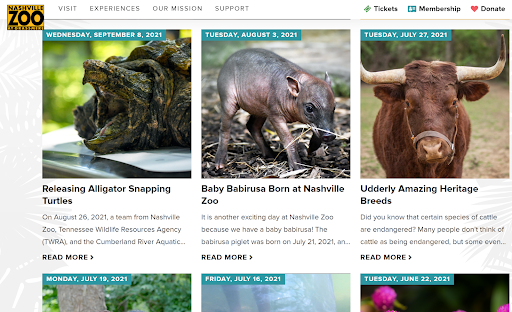
Adding a blog to your site is also important for helping your organization get noticed. Websites with blogs are more SEO-friendly than sites without and they typically contain more keywords related to your mission. So, your site is likely to rank higher in search engine results, which can help attract more potential volunteers and donors.
» Don’t have a blog yet? Check out this guide for starting a blog.
5. Create a Call to Action
Once you’ve introduced your nonprofit and gotten visitors excited about the work you’re doing, it’s important to give those visitors an outlet for their excitement. With a call to action, you give supporters a way to contribute to your efforts.
Deciding what, exactly, your call to action should be is extremely important and will depend on what your nonprofit needs. If you want people to volunteer, for example, you can encourage visitors to sign up for a volunteer position or register for an event. If you’re soliciting donations, your website should funnel visitors towards a donation page.
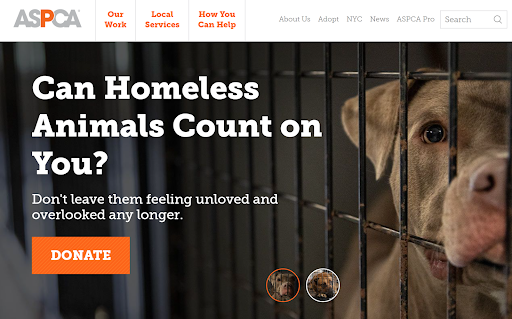
Be sure to place call-to-action buttons and links strategically around your site, including on your homepage, mission page, and blog posts. Don’t be afraid to experiment with the placement and language of your calls to action—but do keep track of the results as you make changes.
6. Make Donations Simple
If your nonprofit accepts donations, it’s important to keep the payments process as seamless as possible. The more professional and easy to use your donation page and payment gateways are, the more likely visitors are to follow through with giving. Notably, many of the top website builders, including inexpensive builders like GoDaddy and HostGator, are designed for e-commerce and can securely process credit and debit card payments on your organization's behalf.
You can also make things easier for donors with a few simple tweaks to the basic checkout process. For example, you can display preset donation amounts in addition to a box where donors can choose to give a custom amount. You can also enable donors to set up monthly or annual recurring donations. Don’t forget to collect donors’ addresses so you can send a thank-you note or gift.

» Want people to stay on your site for longer? Try these tips for improving user experience.
7. Offer Contact Information
A big part of growing a nonprofit is connecting with new people and establishing new partnerships. Your website can play a major role in that process if you include a way for visitors to get in touch with your team.
At a minimum, you should list an email address or phone number that goes to your organization’s headquarters. If you have specific project leads, it’s also a good idea to include contact information for each of those staff members. Alternatively, you can set up a form on your website and let visitors choose from a drop-down menu of different topics about which they may be getting in touch.
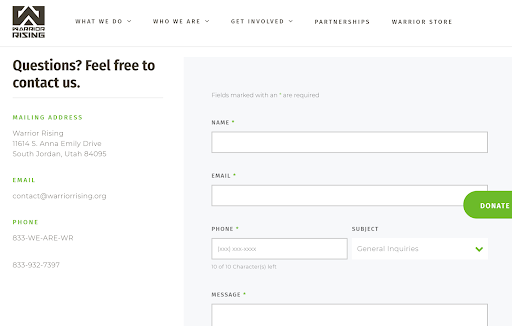
8. Connect to Social Media
Another way to increase your website’s reach and impact is to connect to your nonprofit’s social media accounts. This enables you to, for example, publish new blog posts to Facebook and Instagram at the same time they go live on your website. You can also give donors the option to share their donation on social media, letting everyone in their networks know about your organization and encouraging them to give as well.
Simply adding social media buttons to your website can also have long-term benefits for engagement between the public and your nonprofit. If these buttons help you build a robust following on, say, Facebook, you can use your page there to share announcements about volunteer events, fundraising drives, new projects, and more.
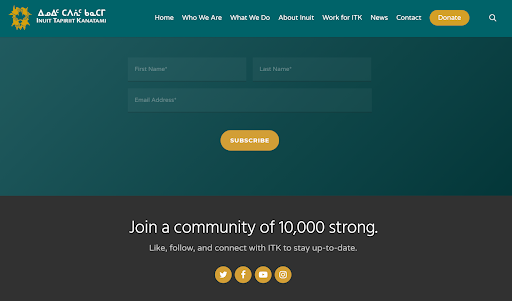
» More: First post ideas for introducing your business on social media.
9. Use Multimedia to Tell Your Story
For any nonprofit website to stand out, it’s important to use media to show off the work you’re doing. Professional images and videos can go a long way towards personalizing your organization’s mission for viewers and spur them to donate or volunteer. In addition, multimedia can play an important role in illustrating concepts or walking visitors through a complex set of problems.
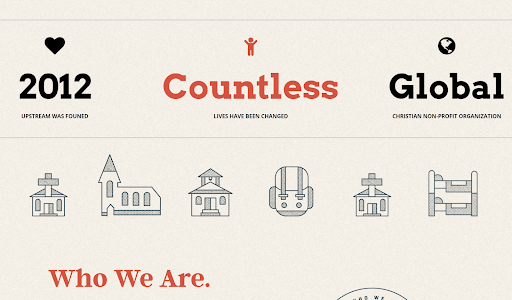
Keep in mind that you’re not limited to just using photos and videos on your website. Illustrations, animations, maps, timelines, and other types of multimedia can all help to get your point across to visitors.
10. Make Sure Your Site Works on Mobile
More than half of all website visits today take place on mobile devices. So, it’s critical to make sure that your website works just as seamlessly on a smartphone as it does on your computer. Otherwise, you could be driving away potential donors.
Thankfully, all of the templates offered by top website builders are mobile-friendly by default and with mobile responsiveness in mind. Some builders, like Weebly and Squarespace, even let you directly customize the mobile version of your site. That’s a big advantage because you can make sure that your mission statement, call to action, and other essential site elements feature prominently when a visitor first lands on your mobile site.
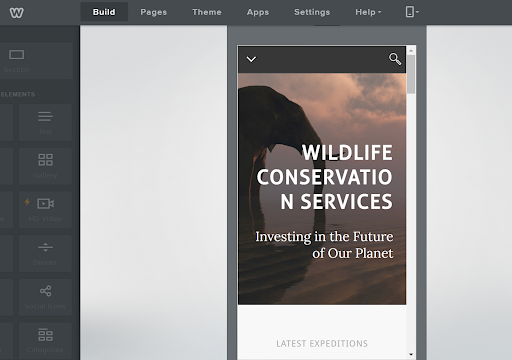
Bottom Line
Your website is the online home of your organization and one of the key platforms your nonprofit can use to attract volunteers, donors, and partners. A well-designed website will clearly explain your mission and projects, keep the public and key stakeholders up to date on your work, and drive donations and volunteerism on your organization’s behalf. Check out our list of the top 10 website builders to start crafting a website for your nonprofit today.
» Don’t feel like designing your website yourself? Try these Wix templates.
Michael Graw is a freelance writer specializing in finance, business, and tech who writes for Top10.com. His work has appeared in numerous well-known online and print publications, including Techradar, BestMoney, Business2Community, Day Trade Reviews, Pacific Standard, Fortune, Business Insider, and more.



